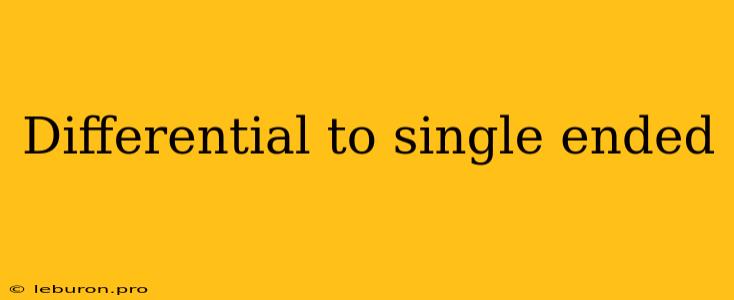In the realm of electronics, signal transmission often involves converting signals between different formats. One common conversion is from differential to single-ended, a process that plays a crucial role in various applications, including high-speed data communication, audio systems, and instrumentation. Differential signaling utilizes two wires to carry a signal, where the data is encoded in the difference between the two signals. Single-ended signaling, on the other hand, uses a single wire to transmit the signal, with a reference point (usually ground) defining the signal's value. This article delves into the nuances of converting differential signals to single-ended signals, exploring the underlying principles, techniques, and applications.
Understanding Differential and Single-Ended Signals
Before delving into the conversion process, it's crucial to understand the fundamental differences between differential and single-ended signaling.
Differential Signaling
Differential signaling employs two wires to transmit data, where the signal is represented by the difference in voltage between the two wires. Each wire carries a signal that is the inverse of the other, resulting in a balanced transmission. The key advantages of differential signaling include:
- Improved Noise Immunity: Differential signals are inherently less susceptible to noise interference due to the common-mode rejection inherent in the design. Any noise picked up by both wires will be cancelled out when the difference is calculated.
- Higher Data Rates: The balanced nature of differential signals allows for faster data transmission rates with reduced signal distortion.
- Increased Signal Integrity: The balanced nature of the signals reduces reflections and crosstalk, enhancing signal integrity and reducing bit errors.
Single-Ended Signaling
Single-ended signaling utilizes a single wire to transmit data, with the signal voltage referenced to a common ground point. This simplicity makes it a popular choice for many applications, particularly those with low data rates and where noise immunity is less critical. However, single-ended signals are more susceptible to noise interference and have lower bandwidth capabilities compared to their differential counterparts.
Differential to Single-Ended Conversion
The conversion from differential to single-ended signaling is a crucial step in many electronic systems. It allows the integration of differential signals into systems that utilize single-ended input or output. This conversion process typically involves an operational amplifier (op-amp) configured in a non-inverting or inverting configuration.
Non-Inverting Configuration
In a non-inverting configuration, the op-amp is used to amplify the difference between the two differential signals. The output of the op-amp provides a single-ended signal that is proportional to the differential input. This configuration preserves the polarity of the original signal.
Inverting Configuration
An inverting configuration uses the op-amp to amplify the difference between the two differential signals while inverting the output signal. This configuration is useful when a negative-going single-ended signal is required.
Techniques for Differential to Single-Ended Conversion
Various techniques are employed for converting differential signals to single-ended signals. Some common methods include:
- Passive Termination: This simple approach involves using a resistor to terminate the unused wire of the differential pair to ground. This technique is suitable for low-speed applications where noise immunity is less critical.
- Active Termination: Active termination uses a buffer or an amplifier to actively terminate the unused wire. This technique provides better noise immunity and signal integrity compared to passive termination, making it suitable for high-speed applications.
- Op-Amp Based Conversion: As discussed earlier, op-amps are commonly used to convert differential signals to single-ended signals. The op-amp's high input impedance and gain provide a stable and accurate conversion.
- Differential to Single-Ended Converters: Specialized integrated circuits (ICs) are available that perform the differential to single-ended conversion. These ICs offer improved performance, reduced component count, and lower power consumption.
Applications of Differential to Single-Ended Conversion
The conversion from differential to single-ended signals finds wide applications in various fields, including:
- High-Speed Data Communication: In modern computer systems and networking devices, differential signaling is widely employed for high-speed data transmission. To interface with single-ended peripherals, differential to single-ended conversion is crucial.
- Audio Systems: Differential signaling is used in high-quality audio systems to enhance signal integrity and reduce noise. Converters are employed to interface with single-ended audio equipment.
- Instrumentation: Differential signaling is often used in instrumentation systems for sensitive measurements. Differential to single-ended conversion allows the integration of differential signals with single-ended data acquisition systems.
- Industrial Control: In industrial automation and control systems, differential signaling is used to ensure reliable communication over long distances. Converters are employed to interface with single-ended control systems.
Conclusion
Converting differential signals to single-ended signals is a fundamental process in electronic systems. Understanding the principles and techniques involved enables engineers to seamlessly integrate differential signals into applications that require single-ended inputs or outputs. The choice of conversion technique depends on factors such as data rate, noise immunity, cost, and power consumption. The applications of differential to single-ended conversion span across various industries, showcasing its importance in modern electronic design.
